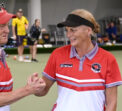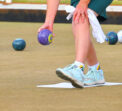To stop or to lift?
This is appearing at times as a regular point of contention on our greens. If a bowl is encroaching your rink on the correct or incorrect bias, do you stop the bowl, return it to the bowler, or do you lift any bowls in the way of the intruding bowl?
What do the Laws of the Sport tell us?
Law 37.6 Bowl displacement by a bowl from a neighbouring rink:
- Law 37.6.1.1 states to lift the bowl at rest to allow the other bowl to pass and then replace it, as long as this action would not influence the outcome of the head.
- Law 37.6.1.2 states to stop the bowl from the neighbouring rink.
- Law 37.6.3 states that if a bowl that has been stopped was in its original course and delivered on the correct bias that would have taken it back into its own rink, it must be replayed.
Now consider Law 60 which clearly states that no controlling body or individual has the right or power to contract out any Laws of the Sport of Bowls.
When we consider all the above laws, the answer is simple. A bowler can stop the bowl and return it or lift a bowl to allow the other bowl to pass.
However, the preferred practice in Australia is to stop the bowl. This preferred practice is taught to new umpires or officials during current accreditation. This practice has been approved through the National Officials Advisory Group (NOAG) for Bowls Australia, who oversees the National Officials Accreditation Scheme (NOAS).
What is the thinking behind the preferred practice of stopping an encroaching bowl from another rink? Interestingly Law 37.6.2 states that during a singles game, a marker must stop the bowl from the neighbouring rink.
- When you lift a bowl it’s most unlikely it will be returned to its exact position (and this could affect the result of the end).
- The law only refers to lifting a bowl and not multiple bowls. I have observed what almost becomes a comedy routine of lifting two or three bowls and even a jack. I have observed people stumble when trying to maneuver lifting multiple bowls.
- Stopping a bowl is a clearer and cleaner process and it less likely to cause a head to be disturbed.
In summary the Laws of the Sport allow a player to stop a bowl or lift a bowl that is stopping the bowl returning to its correct rink. Both are correct, however the preferred process is to stop the bowl and return it to the bowler but only if the bowl was on a path to bring it back into the rink. A bowl on the wrong bias would not be returned. If the bowl is not on a path to bring it back, it is a dead bowl and should not be returned.
Playing coaches – where and when can they give their advice?
Law 44 clearly sets out the duties of a coach. This being either a coach of a team, a player, or a side. It is under the following conditions and situations:
- The umpire must be informed before the game starts who the coach is.
- Only one nominated person can give such advice.
- This advice can only be delivered when their team is in possession of the rink and advice must be given from outside the boundaries of the green.
Therefore, in a team game like pennant a coach cannot be yelling instructions across the green or standing on an adjoining rink and providing advice while the game is in progress.
Can you delay your rink of play to wait for other rinks to finish?
Put simply, the answer is no.
Slow or delaying play is in the CoP for Metro and Regional Pennant and State Events.
If an umpire by their own observation or on appeal by a side manager decides a player is deliberately delaying the delivery of their bowl, or a skip is acting or issuing instructions designed to delay play, a warning will be issued to the skip, and the side manager must be advised. Waiting for another rink to complete their end is clearly delaying play and not in the spirit of the game. The umpire would need to instruct the player to play their bowl.
It is unreasonable for a team to stop in the middle of a rink or the end of the rink for every end for any significant length of time. Especially if the opposition player is on the mat ready to deliver their bowl.
If an umpire forms the opinion that the player or skip has repeated the same offence a second time, the end will be regarded as completed, with their opponent awarded as many shots as there are bowls in use by their opponent.
If the player refused to follow the umpires’ instructions one option would be to carry out Laws C2 and C10 – The game is awarded to their opponent or opposing side. One would hope this situation would never arise as common sense should always prevail.
Playing Three vs Four in Pennant.
Gone are the days when we had to apply Law 39.2.2.2 where one fourth of the total shots scored (including decimal points) by each defaulting team had to be deducted from when the team became three players. Fortunately, Law 39.2.3 allows Member Nation Authorities to approve regulations which are different from those mentioned in Law 39.2.2.2.
In Australia our Domestic Regulations (DRs) 2.6 state that when a player becomes absent in a side game (Pennant), and there is no suitable substitute available the team with the absent player plays as though the second is missing, (DR 2.6.1.1).
When this occurs, the Skips should carry the card (as the scorecards need to be at the same end for comparison of scores). This is the preferred practice.
The LAWMAN.
John Roberts
Co-Chairman
Officiating and Laws Committee




